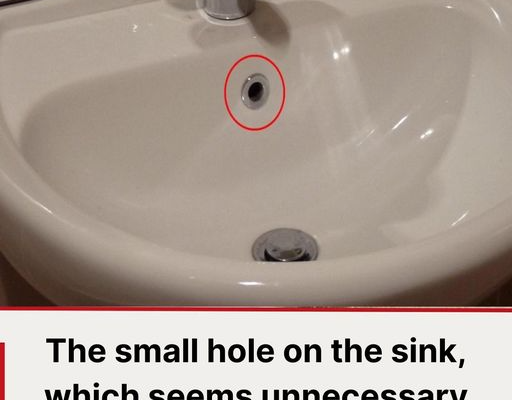Have you ever noticed a small hole near the top of your bathroom sink, just below the faucet? Many people see this tiny opening and wonder if it’s just a strange part of the design, or if it actually serves a real purpose. Well, it turns out that this little hole is quite important and serves a specific function, which can save you a lot of trouble when you least expect it.
Bathroom renovations

What’s the Purpose of That Small Sink Hole?
That small hole you see near the top of your bathroom sink is called an overflow hole, and it’s a lot more useful than it might seem at first glance. Positioned about one-third of the way down from the top of the basin, this modest opening was carefully designed to handle common, everyday situations. It’s a safety feature that helps prevent something almost all of us have done—accidentally overflowing the sink.
Picture this: You’re filling up your sink, maybe to do a quick rinse of some clothes or to fill it with warm water for a soak, and something interrupts you. Perhaps your phone rings, or you get distracted by something urgent happening in another room. You walk away for a few minutes, and without an overflow hole, the water could soon be spilling over the edge of the sink, all over your bathroom floor.
That’s where the overflow hole comes in. Its job is to act as a safety net, redirecting excess water before it becomes a disaster. The hole is connected directly to the drainage system under the sink, so once the water level gets high enough to reach the hole, the extra water is channeled through it and safely into the drainpipe below. This prevents flooding and keeps your bathroom floor from turning into a waterlogged mess. It’s a simple feature, but it can save you from the hassle of mopping up gallons of water and dealing with potential damage to your bathroom.
Overflow Hole: The Silent Protector
The overflow hole isn’t just a backup feature for when you forget to turn off the tap—it also helps improve drainage in general. When you’re draining a full sink, the overflow hole allows air into the pipe, which speeds up the drainage process. Without this extra airflow, draining might be slower due to the formation of a vacuum inside the pipes.
Think of the overflow hole as the sink’s silent protector, always there, making sure your bathroom doesn’t turn into a mini water park. This is especially helpful if you have young kids who may forget to turn off the tap, or if you are just easily distracted. The overflow feature provides peace of mind, knowing that your sink has an extra layer of security against accidents.
The Downsides of the Overflow Hole
However, despite its many benefits, the overflow hole does have a downside. Because it’s located in a spot that’s not easy to see or reach, it tends to be neglected during routine cleaning. Over time, this little opening can collect grime, soap scum, and bacteria, which can lead to some pretty unpleasant odors coming from your sink. If you’ve ever noticed an odd smell in your bathroom and couldn’t quite figure out where it was coming from, there’s a good chance that the overflow hole is the culprit.
Since it’s connected to the drainage pipe, the overflow hole is exposed to moisture almost all the time, making it a prime location for mold and bacteria growth. The result is that unpleasant, musty odor that seems to come from nowhere but actually has a simple cause—and, fortunately, a simple fix.
How to Clean Your Overflow Hole
Keeping your overflow hole clean doesn’t take a lot of time, and it can make a big difference in the overall hygiene of your bathroom. One of the easiest and most effective ways to clean it is to use a combination of vinegar and baking soda. These common household items create a powerful reaction that can help break down buildup and eliminate odors.
Here’s how to do it:
- Prepare Your Cleaning Solution: Mix equal parts baking soda and white vinegar. You won’t need much—just enough to fill a small cup should do the trick.
- Apply the Mixture: Pour the mixture directly into the overflow hole. You might want to use a small funnel or a squeeze bottle to make sure the mixture goes into the hole instead of spilling over the sink.
- Let It Sit: Once the vinegar and baking soda come into contact, they will start to bubble and fizz. This is normal and means that the solution is working to break down the buildup inside the overflow pipe. Allow this mixture to sit for about five to ten minutes.
- Flush with Warm Water: After letting the mixture work its magic, rinse thoroughly with warm water. You can pour the water directly into the overflow hole or run the faucet and let the water drain through it. This will help flush out any debris that the chemical reaction has loosened up.
Tips for Regular Maintenance
It’s a good idea to clean your overflow hole at least once a month, especially if you notice an unpleasant smell coming from your sink. Keeping this part of your bathroom clean will prevent bacteria and mold from accumulating, ensuring that the overflow hole can continue to function properly.
You can also use a small bottle brush to gently scrub the inside of the overflow hole after applying the vinegar and baking soda. This will help remove any stubborn deposits that the cleaning solution might not have fully dissolved. Be sure to be gentle, as you don’t want to scratch the porcelain or damage the drain system.
Final Thoughts
The humble overflow hole in your bathroom sink might seem like an insignificant detail, but it’s actually a crucial part of keeping your home safe from accidental flooding. It’s there to prevent those “oops” moments from turning into major problems, and it helps with drainage efficiency as well. However, like any part of your home, it needs a little bit of care and attention to stay in good working order.
So, the next time you’re cleaning your sink, take an extra few minutes to care for the overflow hole. A little vinegar, baking soda, and warm water can go a long way in ensuring that this often-overlooked feature continues to work its magic. It’s a small step that can help you maintain a cleaner, fresher-smelling bathroom while ensuring that your sink works as it should. Sometimes, it’s the smallest details that have the biggest impact on keeping our homes comfortable and functional.

